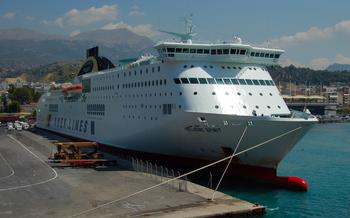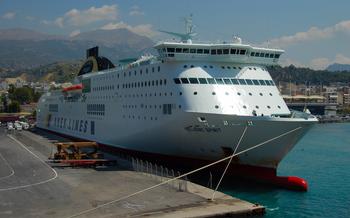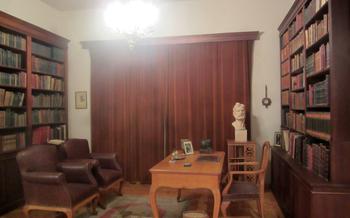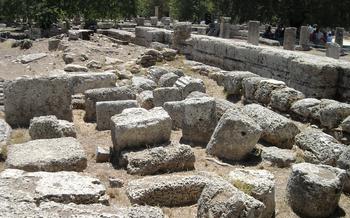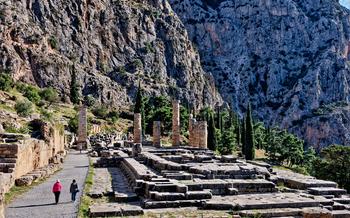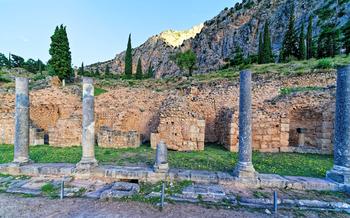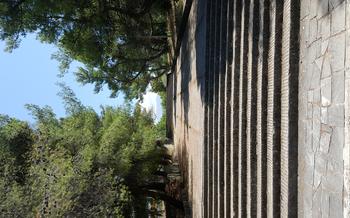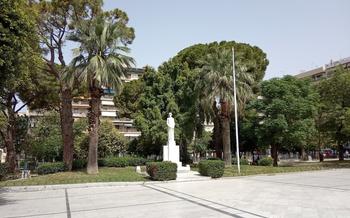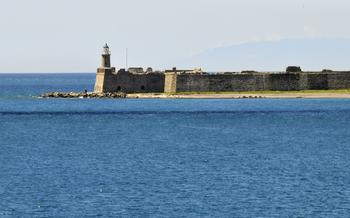
The Turkish Baths
- A City with History
- The Turkish Baths
- A Unique Experience
- Preparing for Your Visit
- The Hammam Ritual
- Benefits of the Turkish Baths
- Exploring the Baths
- Local Traditions
- Modern Adaptations
- Cost and Duration
- The Patras Archaeological Museum
- The Rio-Antirio Bridge
- Insider Tip: Exploring Patras Beyond the Turkish Baths
A City with History
Patras, a vibrant city in western Greece, boasts a rich tapestry of history and culture, shaped by the influences of diverse civilizations over the centuries. Its strategic location at the crossroads of major trade routes in the Mediterranean Sea has made it a melting pot of cultures, leaving an indelible mark on its identity.
In ancient times, Patras was a significant city-state, renowned for its oracle of Apollo, which drew pilgrims from across the Greek world. During the Roman period, it became a prosperous port city, connecting the East and West. In the Byzantine era, Patras served as the capital of the Peloponnese, further enhancing its importance as a cultural and administrative center.
Throughout history, Patras has witnessed the rise and fall of empires, each leaving its unique imprint on the city's architecture, customs, and traditions. Its enduring spirit and resilience have made it a symbol of Greece's rich historical heritage, inviting visitors to explore its many layers of history, from ancient ruins to modern landmarks.
The Turkish Baths
Patras' Turkish baths, also known as the Loutra, are a testament to the city's rich cultural heritage. Built during the Ottoman period, these historic bathhouses have been meticulously restored and continue to offer a unique bathing experience. The baths' striking architecture, with its intricate tilework, marble fountains, and domed ceilings, transports visitors back in time. Their historical significance lies in their role as a central meeting point for the community, where people from all walks of life gathered to socialize, relax, and cleanse themselves. The Turkish baths hold a special place in the hearts of Patras residents, who cherish them as a symbol of their city's diverse past.
A Unique Experience
Patras' Turkish baths offer a serene and calming ambiance, a welcome respite from the bustling city. Step inside and you'll be transported to a world of tranquility, where the gentle sound of water and the soft murmur of conversation create a soothing atmosphere. The baths combine traditional elements with modern amenities, ensuring a comfortable and enjoyable experience.
As you relax in the warm embrace of the bathing chambers, you'll feel the weight of the world melt away. The intricate tilework, the soft lighting, and the aromatic steam combine to create a sensory experience that will leave you feeling refreshed and rejuvenated. The Turkish baths offer a glimpse into the region's rich past, where bathing rituals were an integral part of daily life. Here, you can step back in time and experience the same traditions that were cherished by generations before.
Preparing for Your Visit
To start your Turkish bath journey, it's essential to make a reservation in advance. This will ensure availability and a smooth experience. When packing, remember to bring a swimsuit, towel, and flip-flops. These items are necessary for your comfort and hygiene during the bathing ritual.
Before entering the baths, it is crucial to understand Turkish bath etiquette. Respect for the tradition and other bathers is paramount. For instance, it's customary to maintain a quiet and peaceful environment, allowing everyone to fully immerse themselves in the tranquil ambiance.
The Hammam Ritual
The Turkish bath experience consists of a series of distinct stages, each designed to cleanse, relax, and rejuvenate. Upon entering the hot room, bathers are enveloped in the steamy embrace of the humid environment. Here, they begin the process of sweating, releasing toxins and impurities from their skin.
The next stage involves soaping and scrubbing, a traditional practice that removes dead skin cells and promotes deep cleansing. Skilled attendants, known as tellaks, expertly lather bathers with a rich, olive oil-based soap, using kese, a coarse mitt, to exfoliate and stimulate circulation.
Following the soaping, bathers rinse off and proceed to the massage and relaxation area. Here, they recline on heated marble slabs and indulge in a soothing massage, expertly administered by experienced masseurs. The massage releases muscle tension, promotes relaxation, and enhances the overall bathing experience.
After the massage, bathers are encouraged to rest and cool down in the cold room, where they can replenish their hydration levels and gradually acclimatize to the cooler temperature before returning to the bustling city streets.
Benefits of the Turkish Baths
A visit to the Turkish baths provides a multitude of benefits for both physical and mental well-being. The combination of heat, steam, and massage helps to detoxify the body, cleanse the skin, and improve circulation.
The high temperatures and humidity of the steam room induce sweating, which helps to eliminate toxins and impurities from the body. This process can help to improve skin clarity, reduce muscle tension, and alleviate respiratory issues.
The traditional soaping and scrubbing technique employed during the bath further aids in exfoliating and cleansing the skin, removing dead skin cells and promoting the growth of new, healthy skin.
The massage, which is an integral part of the Turkish bath experience, helps to relax and soothe the muscles, relieving tension and stiffness. It also improves circulation, promoting better oxygen and nutrient flow throughout the body.
Exploring the Baths
The Turkish baths are a complex of interconnected chambers, each serving a specific purpose. The central chamber, also known as the hot room, is the heart of the bathing experience. Its high humidity and warm temperature create a soothing and relaxing ambiance. The cold room, on the other hand, provides a refreshing contrast to the hot room, helping to improve circulation and invigorate the senses.
Beyond these two main chambers, the baths also feature a relaxation area, where visitors can unwind and rejuvenate after their bathing ritual. This area is often adorned with comfortable seating, soft lighting, and calming music, creating a tranquil and serene atmosphere.
Throughout the baths, visitors can admire unique architectural features that showcase the blend of Turkish and Greek influences. Intricate tilework, marble columns, and vaulted ceilings add to the overall grandeur and charm of the establishment. Additionally, the baths may house historical artifacts, such as old bathing implements or decorative pieces, that offer a glimpse into the rich history of this ancient tradition.
Local Traditions
In Greek culture, the Turkish baths hold a special significance, deeply rooted in local traditions and customs. They serve as social gathering places where people from all walks of life come together to relax, socialize, and celebrate. Traditionally, the baths were segregated by gender, with separate sections for men and women. Families and friends would often visit the baths together, enjoying the communal experience and strengthening their bonds.
Rituals and customs associated with the Turkish baths have been passed down through generations. For example, it is customary to start the bathing experience with a thorough cleansing, using a kese (a traditional exfoliating mitt) to remove dead skin cells and impurities. This is followed by a relaxing massage, often performed by skilled masseurs who use fragrant oils and techniques to promote deep relaxation and well-being.
The Turkish baths also play a role in religious and cultural festivals. During special occasions such as weddings or religious holidays, the baths are often decorated with flowers and candles, and special ceremonies and rituals are performed to mark the occasion. These traditions add to the cultural richness of the Turkish baths, making them an integral part of the local heritage and identity.
Modern Adaptations
Over the years, the Turkish baths in Patras have undergone various modern adaptations to cater to the needs of contemporary visitors. These adaptations have been carefully implemented to preserve the traditional essence of the baths while enhancing the overall experience.
One notable adaptation is the incorporation of modern amenities such as private changing rooms, lockers, and showers. These facilities provide a greater level of comfort and privacy for visitors, while still maintaining the traditional communal bathing experience.
Additionally, traditional practices have been blended with contemporary techniques to enhance the bathing experience. For instance, some baths have introduced the use of essential oils and aromatic steam to create a more relaxing and therapeutic atmosphere. These modern touches complement the traditional rituals, offering visitors a unique and revitalizing experience.
Recognizing the growing interest in cultural tourism, many Turkish baths in Patras have become more accessible to international visitors. They have implemented multilingual signage, offer guided tours in various languages, and provide English-speaking staff to assist visitors from different backgrounds. This accessibility allows tourists to fully immerse themselves in the history and traditions of the Turkish baths, fostering cross-cultural understanding.
Cost and Duration
The cost of a Turkish bath experience in Patras typically ranges between 10 to 20 euros. This includes access to the various sections of the baths, such as the hot room, cold room, and relaxation area. Additional services, such as massages and body scrubs, may come with an extra charge.
The average length of a bathing session is around 60 to 90 minutes. However, visitors are welcome to stay longer if they wish to fully immerse themselves in the experience. Some baths may offer extended packages that include additional services and amenities, such as private changing rooms or personalized treatments.
It's important to note that it's customary to tip the bathhouse attendants for their services. The amount is usually up to the discretion of the visitor, but a small gratuity is generally appreciated.
The Patras Archaeological Museum
The Patras Archaeological Museum is a treasure trove of artifacts and antiquities that narrate the rich history of the region. Set within a stately neoclassical building, it houses an impressive collection that transports visitors back to ancient times.
Exhibits range from prehistoric tools and pottery to sculptures, inscriptions, and everyday objects from the various civilizations that have graced this land. Discover the intricate artistry of ancient Greek pottery, marvel at the monumental statues that once adorned temples and public spaces, and decipher the stories etched into stone tablets.
One of the highlights of the museum is the "Patras Charioteer", a stunning bronze statue from the 4th century BC. This life-size sculpture depicts a victorious charioteer in mid-race, capturing the essence of ancient Greek athleticism and artistry.
The museum's collection also offers insights into the region's Roman and Byzantine past, with mosaics, coins, and other artifacts from those periods. Wander through the galleries and let the remnants of history come alive as you piece together the story of Patras and its place in the tapestry of ancient civilizations.
The Rio-Antirio Bridge
A Marvel of Modern Engineering
As you leave the Turkish Baths and venture out to explore Patras further, make sure to include the awe-inspiring Rio-Antirio Bridge in your itinerary. This architectural masterpiece spans the Gulf of Patras, connecting the city to the Peloponnese peninsula. Completed in 2004, the bridge stands as a testament to modern engineering prowess and ingenuity.
As you approach the bridge, its sheer size and scale are sure to captivate you. The bridge's sleek design and graceful curves blend harmoniously with the surrounding landscape, creating a breathtaking spectacle. Take a moment to appreciate the stunning views of the gulf and the distant mountains as you cross this engineering marvel.
Whether you choose to drive or walk across the bridge, the experience is equally thrilling. As you traverse the bridge, marvel at the intricate network of cables and supports that hold this colossal structure in place. The bridge's innovative design allows it to withstand even the strongest winds and seismic activity, making it a symbol of resilience and strength.
The Rio-Antirio Bridge is more than just a transportation link; it has become an iconic landmark and a source of pride for the people of Patras. It has transformed the region, boosting tourism and economic development, while also fostering closer connections between the Peloponnese and mainland Greece.
Don't miss the opportunity to experience this architectural marvel firsthand. As you cross the bridge, take a moment to appreciate the stunning views, marvel at the engineering prowess, and feel the sense of awe that this extraordinary structure evokes. The Rio-Antirio Bridge is a must-see attraction that will leave an unforgettable impression on your visit to Patras.
Insider Tip: Exploring Patras Beyond the Turkish Baths
While the Turkish baths offer a unique and rejuvenating experience, don't miss the opportunity to explore other hidden gems that Patras has to offer. Immerse yourself in the city's rich culinary scene, savoring delicious local specialties at traditional tavernas and restaurants. Venture beyond the city center to discover the breathtaking natural beauty of the surrounding area, with its picturesque beaches, lush countryside, and charming villages. Whether you're a history buff, a nature enthusiast, or simply seeking a relaxing getaway, Patras has something for everyone. So, after indulging in the tranquility of the Turkish baths, be sure to allocate some time to explore the city's vibrant culture, stunning landscapes, and warm hospitality.
